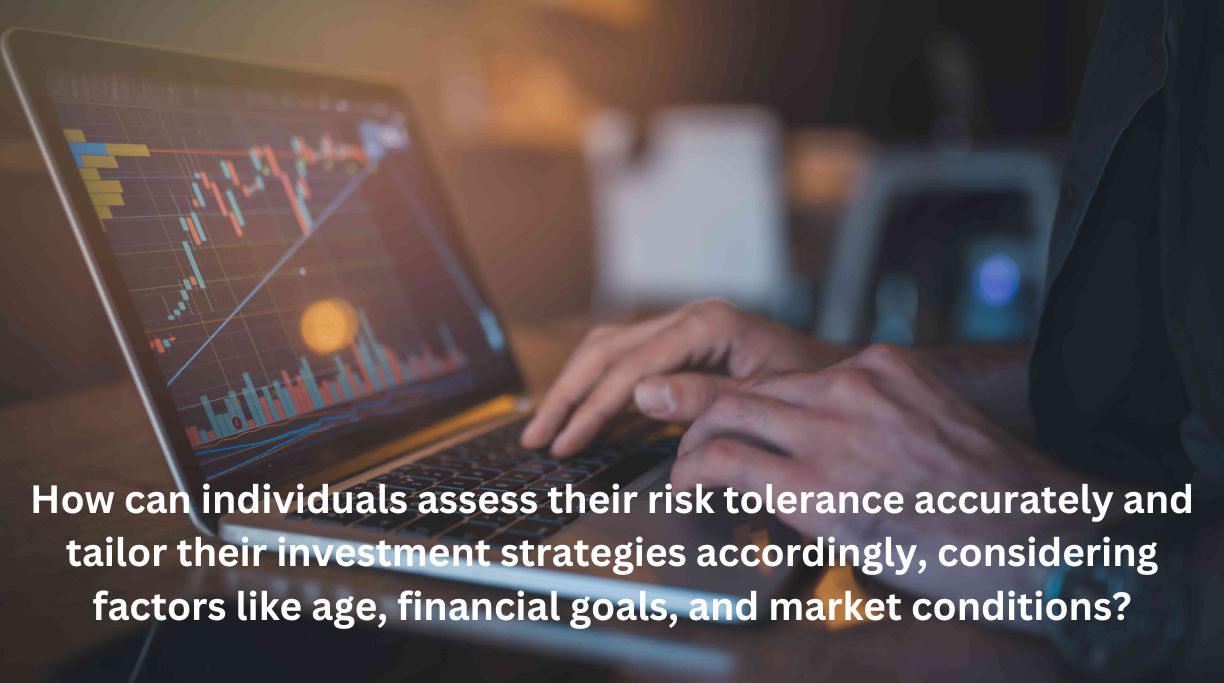Financial planning must include investing, but investing is not a one-size-fits-all process. Knowing how much risk you can afford to take is essential to creating investing plans that suit your unique needs and preferences. We’ll examine the complex process of precisely determining your risk tolerance and developing investment plans that work for your age, your financial objectives, and the state of the market in this post.
Which Elements Affect Risk Tolerance?
A. Age
When it comes to investing, age is more than just a number—it’s a key factor in determining your level of risk tolerance. Younger people can recover from possible losses over time because they often have longer investing horizons. Being able to withstand transient market swings frequently corresponds to a greater risk tolerance. On the other hand, safeguarding earned wealth becomes critical as people get closer to retirement. In order to reduce exposure to market volatility, this frequently leads to a shift towards more conservative investment techniques. Let’s say you are a thirty-year-old professional with a good source of income. Given their resilience in the face of market downturns, they might be more likely to make aggressive investments in growth-oriented assets like equities. On the other hand, a 55-year-old who is getting close to retirement may choose a more stable and balanced investment strategy over one that prioritizes aggressive development over capital preservation.
B. Monetary Objectives
Your investing path is guided by your financial goals as a compass. Every financial objective, such as accumulating savings for a down payment on a home, financing your kids’ school, or creating a nest egg for retirement, has associated risks. More caution is generally necessary to safeguard capital when pursuing short-term objectives. For example, if your goal is to save money for a down payment on a house within the next two years, then it may not be appropriate to expose those funds to stock market volatility. Long-term objectives, such as retirement planning, on the other hand, permit a more aggressive investment approach since there is more time to recover from market downturns.
C. Situation of the Market
Risk tolerance is greatly impacted by the financial markets’ dynamic environment. Investors may feel more comfortable taking on greater risk when the economy is growing and stable. Investors are frequently encouraged to investigate higher-risk, higher-reward opportunities during bull markets. On the other hand, risk aversion usually rises during uncertain or recessionary economic times. In an effort to preserve their cash and find stability, investors may move their investments toward safer options like gold or bonds. It’s important to remember that the market is dynamic and that your investing strategy needs to be continuously monitored and adjusted. A astute investor stays flexible, adjusting their approach strategically to account for evolving market conditions.
Read Also:
- What educational resources or platforms do you recommend for staying updated on the latest finance and investment strategies, especially for self-directed investors?
- How can individuals assess their risk tolerance accurately and tailor their investment strategies accordingly, considering factors like age, financial goals, and market conditions?
- What educational resources or platforms do you recommend for staying updated on the latest finance and investment strategies, especially for self-directed investors?
- In the context of finance, how do geopolitical events influence investment strategies, and what precautions should investors take to mitigate potential risks?
- What are the prevailing trends in robo-advisors and how do they impact the landscape of personal finance and investment strategies?
Which Techniques Are Used to Determine Risk Tolerance?
A. Surveys
Questionnaires are one of the most popular and easy-to-use tools for determining risk tolerance. These questionnaires are intended to gather details on your financial status, your investment objectives, and—above all—how comfortable you are with risk. Questions may address a range of topics, including your response to market swings, your time horizon, and your financial goals. One benefit of using surveys is that they are easy to use and straightforward. They can be easily accessed online via robo-advisors, financial websites, or even financial institutions themselves. The questions are designed to assess both your willingness and ability to take risks in light of your financial situation.
B. Talking with Financial Counselors
Speaking with a financial counselor is a wise choice for a more thorough and customized evaluation. Financial advisors are educated to examine aspects of your financial situation that go beyond what can be found on a questionnaire. To give you personalized guidance, they can examine your earnings, outgoings, current investments, and long-term financial objectives. The human element that financial advisors provide to the process makes their advice beneficial. They are capable of deciphering subtle nuances in your financial status that computerized surveys could miss. They may also advise you about the possible benefits and drawbacks of different investing techniques, assisting you in making choices that are consistent with your risk tolerance.
C. Introspection
In order to determine your risk tolerance, self-reflection is an essential step that goes beyond using standardized surveys and expert assistance. This approach requires you to reflect on your own beliefs, feelings, and experiences about risk in the financial realm. Consider your level of comfort with market volatility and the possibility of losing money on investments. Consider how your prior financial experiences have influenced your willingness to take risks. Think about your long-term financial objectives and your willingness to accept measured risks in order to reach them. Understanding your own psychological prejudices and having a reasonable degree of financial literacy are prerequisites for self-reflection. Developing an investment strategy that corresponds with your actual risk tolerance can be greatly aided by being truthful with yourself about your comfort level with risk.
Customized Investment Strategies: What Is It?
A. Modest Tactics
The steady hand steering a ship with caution and wisdom is analogous to employing conservative investing tactics. These strategies are best suited for people who are nearing retirement or have a limited risk tolerance since they place a higher priority on capital preservation than aggressive development. A conservative portfolio will have a larger percentage allocated to low-risk investments such as treasury securities, bonds, and steady dividend-paying equities. Although there may not be much room for large profits, the goal is to offer a consistent and dependable source of income with little exposure to market fluctuations. Because their portfolios are predictable, conservative investors can take comfort in the knowledge that they are less vulnerable to the erratic fluctuations in the market. This strategy fits in well with people who value financial security and don’t like the wild ride that comes with adopting more aggressive tactics.
B. Moderate Approaches
For investors who want a mix of stability and capital growth, moderate investing techniques offer a good balance between risk and return. This compromise enables the creation of a diversified portfolio with both aggressive and cautious components. Stocks, bonds, and other assets may be included in a standard moderate portfolio in an effort to maximize growth potential while reducing the effects of market downturns. While acknowledging that investment carries some inherent risk, this strategy aims to manage it through diversification. In order to potentially earn larger profits in the long run, moderate investors frequently have longer time horizons and are prepared to put up with brief market swings. This approach is appropriate for people who wish to maintain some degree of consistency in their financial portfolio without being extremely risk adverse.
C. Bold Approaches
Aggressive investing strategies become the preferred choice for individuals who have a greater tolerance for risk and a desire to pursue larger returns. These approaches are similar to venturing out into unknown seas and accepting market volatility in the hope of achieving significant capital gains. Speculative investments, small-cap companies, and growth stocks are examples of high-risk, high-reward assets that are heavily weighted in aggressive portfolios. There is a chance for large gains, but there is also a chance for large loses. People who can withstand market volatility and have a long investment horizon are the greatest candidates for this technique. In addition to being at ease with the notion of taking measured risks, aggressive investors are frequently proactive in tracking market developments. This strategy is in line with the beliefs of individuals who see investing as an active and dynamic undertaking as opposed to a passive one.
Conclusion
In the ever-changing world of investing, developing a customized plan is essential. Choosing a conservative approach might offer stability, a moderate strategy can offer balance, or an aggressive strategy can offer dynamic tactics. The important thing is to match your investments to your financial goals and risk tolerance. Reevaluating your strategy on a regular basis guarantees that it will remain a reliable guide for your financial journey even as markets change. Recall that there is no one correct course of action; instead, select the one that best suits your particular financial situation and goals. Happy making purchases!
Frequently Asked Questions (FAQs)
- How often should I reassess my risk tolerance and investment strategy?
- It’s advisable to reassess your risk tolerance and investment strategy annually or whenever there are significant life changes, such as marriage, the birth of a child, or changes in financial goals.
- Are there specific tools or platforms for conducting a self-assessment of risk tolerance?
- Yes, various online platforms offer risk tolerance questionnaires. These are user-friendly tools designed to help you understand your comfort level with different levels of risk.
- Is there a one-size-fits-all approach to investment strategies?
- No, each individual’s financial situation is unique. The best investment strategy depends on factors like risk tolerance, financial goals, and time horizon. What works for one person may not be suitable for another.
- How can I stay informed about market conditions and trends?
- Stay informed by regularly reading financial news, following reputable investment blogs, and considering the insights of financial experts. Additionally, financial advisors can provide personalized advice based on market conditions.
- Is it possible to change my investment strategy over time?
- Absolutely. Your investment strategy should evolve with changes in your life, financial goals, and market conditions. Regularly reviewing and adjusting your strategy ensures it remains aligned with your current situation and aspirations.








